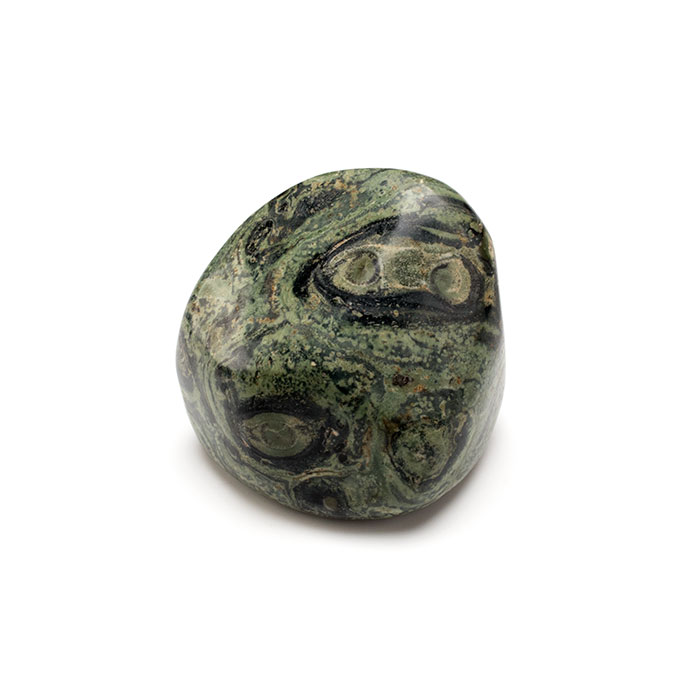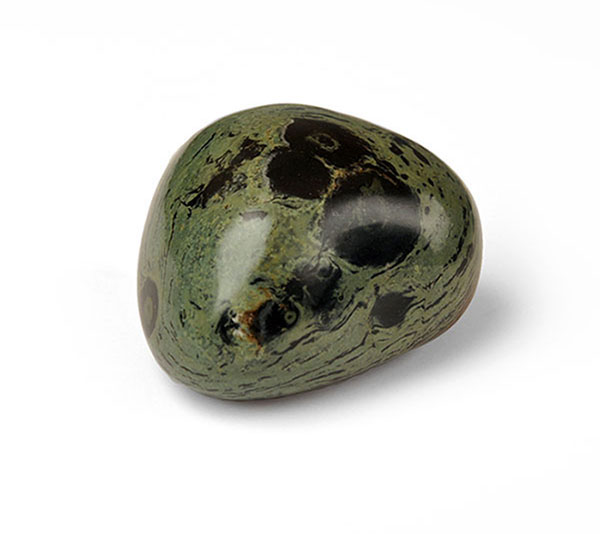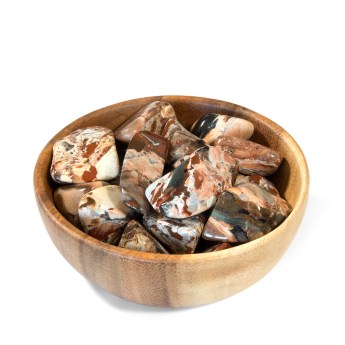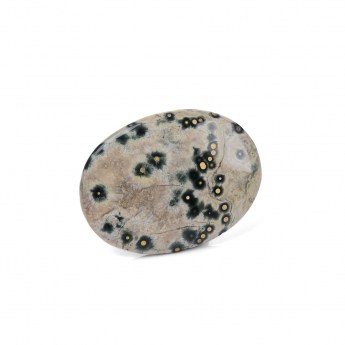Kambaba Jasper: Everything Worth Knowing

| Contents 1. What is Kambaba Jasper? 2. Kambaba Jasper Geology 3 Article Pictures 4. Shop Kambaba Jasper |
What is Kambaba Jasper?
Kambaba Jasper, whose name is geologically incorrect, is a volcanic rock composed of quartz, aegirine, and feldspar. Dark green orbs with fine streaks of amphibole minerals have also been noted.
The unique patterns in Kambaba Jasper are likely to have formed through subtle geological changes after the rock solidified.
Kambaba Jasper, also known as Crocodile Jasper, has only been found in Madagascar. Much of the geological information about this relatively rare stone is incorrect.
Although often referred to as a mineral, Kambaba Jasper is a rock. Describing it as a 'jasper' is geologically incorrect.
The first time I saw Kambaba Jasper was in India in 2002. My supplier told me that it was called Star Galaxy Jasper, but I soon learnt that was a trade name used by local stone cutters.
I've also seen the name Green Stromatolite Jasper being used. A stromatolite is a rock-like structure that forms in shallow waters from the build-up of a group of bacteria called cyanobacteria.
Also known as blue-green algae, cyanobacteria have a fossil record dating back almost three and a half billion years, so some claim Kambaba Jasper is more than three billion years old.

Kambaba Jasper - What the Experts Say
Having researched and written about rocks and minerals for over twenty years, I know that not everything you read is accurate, particularly in articles online.The main reason for this is because so many 'crystal-related 'articles are plagiarised, and few people check for accuracy before republishing something written by someone else.
While researching Kambaba Jasper, I was unable to find a single article that included detailed geological information about the stone's chemical composition. Nor could I find any information about where in Madagascar it was mined.
I then stumbled across a relatively old thread in a forum, started by someone who asked whether Kambaba Jasper was a stromatolite. The replies, which covered several pages, featured arguments for and against.
I found this lengthy response particularly interesting:
"I’ve been sitting on my hands trying to stay out of this debate. There's a lot of hokum and claptrap kicking around concerning this material which has created considerable confusion. Kambaba Jasper is an invented name for what was hailed in the fringes of the lapidary world as a new material but isn’t. It's a relatively newly-discovered exposure of an already known material. It has been studied by experts and isn’t stromatolitic or even sedimentary, at least not in the samples that have been analysed.
 The EPI (Institut für Edelstein Prufüng) or Institute for Gemstone Testing in Germany published a detailed report in one of its bulletins. Unfortunately, they're only available to members and only in German. Nevertheless paraphrasing from their findings; thin-section and X-Ray diffraction analyses have shown the kabamba material is not a type of jasper at all, it is instead volcanic. The green groundmass is composed mainly of quartz, pyroxene (aegirine) with orbs of alkali feldspar embedded with streaky aggregates comprising tiny needles of amphibole (riebeckite to pargasite).
The EPI (Institut für Edelstein Prufüng) or Institute for Gemstone Testing in Germany published a detailed report in one of its bulletins. Unfortunately, they're only available to members and only in German. Nevertheless paraphrasing from their findings; thin-section and X-Ray diffraction analyses have shown the kabamba material is not a type of jasper at all, it is instead volcanic. The green groundmass is composed mainly of quartz, pyroxene (aegirine) with orbs of alkali feldspar embedded with streaky aggregates comprising tiny needles of amphibole (riebeckite to pargasite).The formation is not fully understood but is most likely to be a volcanic rock that has been “overprinted” by a weak metamorphism.
In mineral composition it’s very similar to a rock originating in Mexico that’s generally referred to in the lapidary world as “Eldarite”. The colour is the reverse of the Madagascan material. Eldarite has a dark groundmass and pale orb-like patterns whereas Kabamba Jasper has a pale groundmass and dark orbicles.
Eldarite is also known in America as “Nebula Stone” because after being polished, the patterns resemble nebulae in outer space. The two rocks are nevertheless sufficiently similar from a mineralogical perspective that the EPI recommends the names “Eldarite” and “Kambaba” (with its several spelling variations) should be regarded as synonyms. They also advise the name Kabamba Jasper should be replaced by Kabamba Stone."
(Here's the original)

The thread had been closed for several years, so I asked in another mineralogical forum whether anyone could shed any light on precisely what Kambaba Jasper was.
I received an interesting response from mineralogist and author Marco Campos-Venuti, who had worked as a geologist in Madagascar. He explained that the confusion over whether Kambaba Jasper is a stromatolite has arisen because two different materials with similar names have, over time, become mixed up.
He went on to say that Kambaba Jasper, or Kabamba as it's known locally, is believed to come from an area called Kabamba. Located in the west-central Bongolava region. The name is sometimes written as 'Kambaba.'
The Bongolava region is approximately 200 kilometres west of Madagascar's capital, Antananarivo.
Kambaba Jasper is an oncolite stromatolite, a rock-like structure that forms in shallow seas. It's composed of bacteria that have been replaced by silica over time.
However, it's being mistaken for Kabamby Ocean Jasper, often known simply as Ocean Jasper. Like Kambaba, it can only be found in Madagascar.
A type of spherulitic chalcedony, Ocean Jasper forms in a totally different way. For this reason, from a geological perspective, it's a different stone and is neither a stromatolite nor a sedimentary rock.
He said Ocean Jasper is likely to have been the material examined by the Institute of Gemstone Testing in Germany, mentioned in the forum thread above.
Confusion over the names of the two stones, where they're found, and repeated plagiarism of articles that were already inaccurate has caused no end of confusion.  Some great photos of both stones and my original post are here. Scroll down to almost the end of the thread to see Marco's comments and photos.
Some great photos of both stones and my original post are here. Scroll down to almost the end of the thread to see Marco's comments and photos.
Since writing this article, further discussions have taken place regarding the chemical composition of Kambaba Jasper, and it seems to have finally been confirmed that it's a volcanic rock, a type of rhyolite composed of quartz, aegirine, albite, and feldspar, with needle-like crystals of amphibole minerals.
Therefore, a more accurate name would be Kambaba Rock or Kambaba Rhyolite.
The appearance of another material called Nebula Stone on the market has further complicated matters. Nebula Stone has a very similar appearance and chemical composition, but is only found in Mexico.
The most obvious difference between the two is colour. Kambaba Jasper has black circles on a green background, while Nebula Stone has green circles on a black background.
Much of the Nebula Stone being offered for sale is almost certainly mislabeled Kambaba Jasper. In fact, on one website I found, the seller claimed they had confirmed with their supplier that the stone was Nebula Stone, not Kambaba Jasper, yet the stones in their photos were almost certainly Kambaba Jasper.
This thread on Mindat, the world's largest open database of rocks and minerals, discusses Nebula Stone and Kambaba Jasper in depth. What makes it worth reading are the comments in response to the long opening post, which geologically, are inaccurate.
Article Pictures
The Kambaba Jasper stones in the first three photos and the fourth are from our collection. The stone in the fourth photo is courtesy of Marco Campos-Venuti.
The photo at the top of our article is clickable and redirects to the original image.












